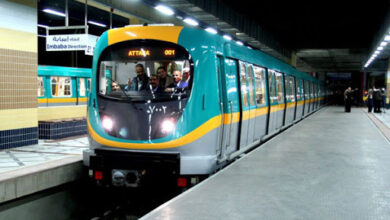The new book entitled “Le Caire – réinventer la ville” – Cairo, reinventing the city – results from collaboration between two researchers from the downtown-based Centre of Economic, Legal and Social Studies and Documentation (CEDEJ) and French photographer Olivier Coret.
Pierre Arnaud Barthel, a French urban planner and development specialist, worked with Egyptian sociologist Safaa Monqid to create the book, which gathers 22 interviews of pioneers in alternative development linked to sustainability in the fields of transportation, building, architecture and renewable energies.
The book, completed just before Egypt's 25 January revolution, was published in April by the French publisher Editions Autrement.
It reviews sustainable initiatives already underway in the Egyptian capital while giving an overview of the monumental task of turning Cairo into a more pleasant living environment for its 20 million inhabitants.
“Beyond the structural and environmental problems that plague the city of Cairo, we wanted to highlight different actors who innovate in the field of sustainability to show the city in a positive light,” explains Barthel, who is conscious that this focus is biased insofar as it ignores the vast majority of people, whose behavior is all but sustainable.
“This is a total challenge, and it can even be perceived as a provocation to write a book on sustainable development in a city like Cairo,” explains Barthel, who considers the Egyptian capital as being one of the world’s less sustainable cities.
Extremely well structured, the book deals with different problems linked to development in six chapters, with each section introducing three to five major players in the field of development, in the shape of straight Q&As or narratives preceded by a brief introduction to set the scene for the interview.
Barthel explains that they decided to have a global approach to the issue of development in Cairo by presenting diversified profiles from the public and private sector, along with actors from civil society and NGOs.
“It seems fairer, and also it enables the reader to connect different approaches to the issue of development,” he says.
The book browses major topics through six chapters, which focus on planning, waste management, transportation, sustainable development and eco-responsible construction, a new generation of sustainable development and finally, ways to reconnect with nature in a polluted environment.
All the actors introduced in this book are convinced that Egypt needs to find its own way to sustainably develop in order to achieve successful change.
No one is more convinced by this statement than Kareem Ibrahim, the technical director for the company in charge of developing Darb al-Ahmar, one of the poorest and most crowded neighborhoods in Islamic Cairo.
This area was chosen by the Aga Khan Development Network to be redeveloped using an approach that integrates building restoration with socio-economic development.
“Cairo’s poor people are very sustainable!” states Ibrahim, who explains that poor people tend to optimize the resources available, as opposed to rich people whose lives revolve around two symbols: the luxurious villa and the personal car.
He explains that 60 percent of waste generated in Darb al-Ahmar is organic and therefore recyclable, while energy consumption is very low. To input sustainability in the popular neighborhood, Ibrahim prefers to recycle construction materials already present in the area and install natural type of ventilation systems in order to reduce energy consumption.
“What we wanted to do with this project was to show the authorities, residents and the NGOs that change is possible,” Ibrahim explains.
This regeneration project was identified in 2008 by the United Nations as one of the most innovative projects of its kind, and it was awarded the international best practice label.
The section dedicated to waste management presents new challenges for the collecting and sorting garbage. The current system is unstable due to the shifting balance of power between the garbage collectors, or zabaleen, and international companies – a process which accelerated in 2009 when the Egyptian government decided to cull the nation's 300,000 pigs in response to the H1N1 virus, thereby destroying what was once widely considered one of the most efficient recycling systems in the world.
The pigs, previously the mainstay of the zabaleen's livelihood, were responsible for consuming much of the city's organic waste and were eaten by the country's 8-million-strong Christian minority. The move to slaughter, which was widely condemned by NGO's and international rights organizations as unfair to Egypt's Christian minority, was seen as a major blow to sustainability.
Despite the setback, the zabaleen continue to recycle and sell non-organic waste such paper, tin, rags, plastics, and cloth. Goats eat some of the organic waste, but they have not proven as effective as pigs in filling the void.
Amin Said Abdel Muti Khayal is the director of the Central Administration of Garbage and Hazardous Waste within the Ministry of Environment. His main proposal to facilitate waste processing in a city that produces 14,000 tons of waste on a daily basis is to push big private companies to integrate the zabaleen by signing contracts with cleaning companies to ensure that no one is aggrieved.
According to him, these two actors of waste processing have to work hand in hand in a clear division of labor in order to succeed in getting rid of Cairo’s garbage.
In one of the garbage collectors’ neighborhood, Manshiyet Nasr, located on the slope of the Moqattam east of Cairo, Hanna Fathy develops solar water heaters on the rooftops of one of Cairo’s poorest neighborhoods to reduce electricity bills.
He also discusses biogas, an energy-saving system that produces energy through the use of organic waste.
“The principle is simple: organic waste has to ferment for 24 hours, and through a process called anaerobic digestion; it produces about two hours of gas every day,” Fathy explains.
Looking into the future, Fathy is already thinking of setting up a waste mixer and closely watching the developments of wind energy.
Many other pioneers expose their dynamism, creativity and hopes for a more sustainable Egypt through the pages of this book, which is for now only available in French, but may be translated to English and Arabic in the near future.




